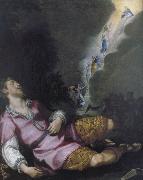Wholesale Oil Painting No Minimum |
|||||||||||
|
|
|||||||||||

|
|||||||||||
|
|
|
||||||||
Ludovico CigoliItalian Baroque Era Painter , 1559-1613 was an Italian painter and architect of the late Mannerist and early Baroque period, trained and active in his early career in Florence, and spending the last nine years of his life in Rome. Lodovico Cardi was born at Villa Castelvecchio di Cigoli, in Tuscany, whence the name by which he is commonly known. Initially, Cigoli trained in Florence under the fervid mannerist Alessandro Allori. Later, influenced by the most prominent of the Contra-Maniera painters, Santi di Tito, as well as by Barocci, Cigoli shed the shackles of mannerism and infused his later paintings with an expressionism often lacking from 16th century Florentine painting. For example, for the Roman patron, Massimo Massimi, he painted an Ecce Homo (now in Palazzo Pitti). Supposedly unbenknownst to any of the painters, two other prominent contemporary painters, Passignano and Caravaggio, had been requested canvases on the same theme. It is unclear if they are completely independent. Cigoli's painting seems to have been made with knowledge of Caravaggio's canvas; however, while Cigoli's work lacks the power of Caravaggio's naturalism, the background shade and sparse foreground shows how much he was moving away from crowded Florentine historical paintings. This work was afterwards taken by Bonaparte to the Louvre, and was restored to Florence in 1815. One of his early paintings was of Cain slaying Abel. |
||||||||
|
|
||||||||
songe de hacob
songe de hacob Painting ID:: 71055 |
mk289 nancy musee des beaux arts mk289 nancy musee des beaux arts |
|||||||
|
CONTACT US |

